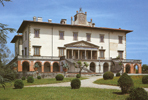 Within architecture it was clear that a new period had began. Besides churches and other public buildings also prestigious houses were being built. During the
Middle-Ages only the Church or the State were able to have prestegious projects contructed. In
Within architecture it was clear that a new period had began. Besides churches and other public buildings also prestigious houses were being built. During the
Middle-Ages only the Church or the State were able to have prestegious projects contructed. In
 the Renaissance also the wealthy among the people had a pallazzo (villa in the city) or a villa (villa outside the city) constructed for themselves.
the Renaissance also the wealthy among the people had a pallazzo (villa in the city) or a villa (villa outside the city) constructed for themselves.
The early Renaissance Architecture was developed in Florence, Italy. In those years the people considered the influence of Florence in politics and culture comparable to the role of Athens in the age of Perikles. The image of Florence as the new Athens must have been very impressive because from around 1400 the people of Florence began to complete all existing artwork and also started many new contructions. The self-assured attitude of the people as well as their urge to amaze other cities, made Florence the centre of the early renaissance art. The ancient Greek and Roman cultures formed their source of inspriration because these cultures were seen as the highest form of civilization human had ever reached.

Fillippo Brunnelleschi can be  seen as the founder of the Renaissance Architecture. His obvious interest in technology and science shows itself in the contruction of the dome of the Cathedral of Florence, the Santa Maria del Fiore (1420-1434). The dome is 90 meters heigh with a diameter of 45 meter. In those days the highest dome ever build. The enormous dome rests on four nearly invisible pillars constructed in the walls and in perfect harmony with the rest of the building it reveals nothing of its gigantic weight. In short a building that reflects harmony, balance and enlightment though the plan of the building was based on the Romaine cross, dating from the Middle-Ages.
seen as the founder of the Renaissance Architecture. His obvious interest in technology and science shows itself in the contruction of the dome of the Cathedral of Florence, the Santa Maria del Fiore (1420-1434). The dome is 90 meters heigh with a diameter of 45 meter. In those days the highest dome ever build. The enormous dome rests on four nearly invisible pillars constructed in the walls and in perfect harmony with the rest of the building it reveals nothing of its gigantic weight. In short a building that reflects harmony, balance and enlightment though the plan of the building was based on the Romaine cross, dating from the Middle-Ages.
Later on their pursuit for harmony and the exact right proporsions and balance was even further emphazised by use of the central plan based on the Greek cross as well as the geometric circle. Perfect symmetry was used to express the ultimate balance and therefore harmony.
 One of the highlights in the late Renaissance Architecture is the Tempietto, build in 1502 by Donato Bramante. The central plan, the columns, etc: everything shows the influence of the Ancient Classic Period.
One of the highlights in the late Renaissance Architecture is the Tempietto, build in 1502 by Donato Bramante. The central plan, the columns, etc: everything shows the influence of the Ancient Classic Period.
Nearly all buildings contructed in the 16th century follow these principles and clearly show the influence of the ancient Greek and Roman cultures.


